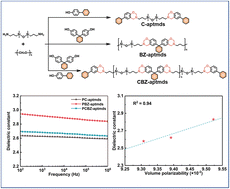Molecular-level insight into the low-k properties and regulatory mechanisms of polybenzoxazines†
Abstract
The increasing demand for high signal transmission speed and low loss is attracting research efforts to design low dielectric constant (low-k) polymers. In this paper, a novel cyclohexyl-containing main-chain benzoxazine BZ-aptmds was prepared. 4-Cyclohexylphenol was employed as a capping agent to react with the polar groups at the end of the chain and control the molecular weight of polybenzoxazine. Then, a polybenzoxazine named PCBZ-aptmds with a low dielectric constant (2.62), low dielectric loss (0.0042), low water absorption, and good thermal properties was prepared. To deeply explore the effect mechanism of polybenzoxazines, molecular models were established according to density functional theory and molecular dynamics simulation. The volume polarizability and proportion of non-polar domains simulated from molecular-level insight have an excellent correlation with the experimental dielectric constant. In particular, the theoretically calculated values of the dielectric constant of three polybenzoxazines are in good agreement with the experimental results.



 Please wait while we load your content...
Please wait while we load your content...